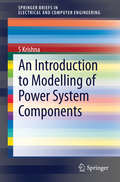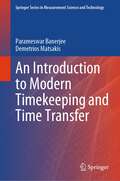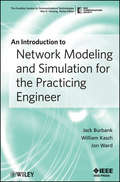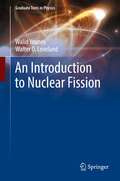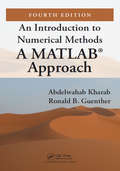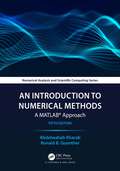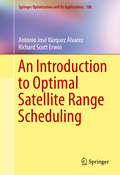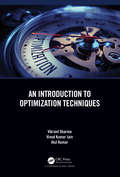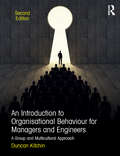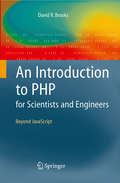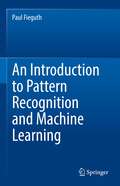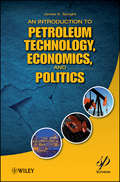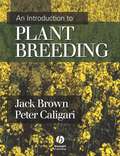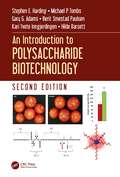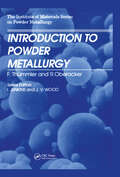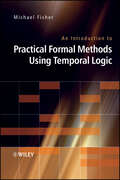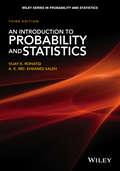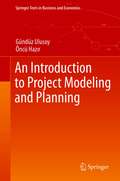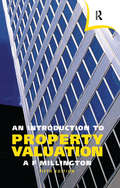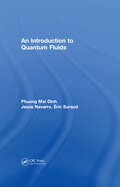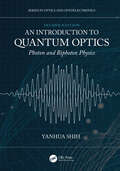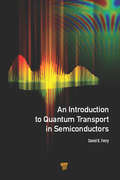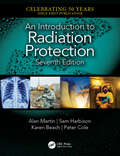- Table View
- List View
An Introduction to Modelling of Power System Components (SpringerBriefs in Electrical and Computer Engineering)
by S KrishnaThe brief provides a quick introduction to the dynamic modelling of power system components. It gives a rigorous derivation of the model of different components of the power system such as synchronous generator, transformer, transmission line, FACTS, DC transmission system, excitation system and speed governor. Models of load and prime movers are also discussed. The brief can be used as a reference for researchers working in the areas of power system dynamics, stability analysis and design of stability controllers. It can also serve as a text for a short course on power system modelling, or as a supplement for a senior undergraduate/graduate course on power system stability.
An Introduction to Modern Timekeeping and Time Transfer (Springer Series in Measurement Science and Technology)
by Parameswar Banerjee Demetrios MatsakisThis book provides a comprehensive, systematic description of modern timekeeping and its specializations. Introductory chapters discuss the concept of time and its definition, then briefly look at pre-Atomic Era timekeeping to set the stage for the introduction of the atomic clock. Subsequent chapters focus on concepts such as frequency stability and measurement uncertainty, as well as computer network time-synchronization protocols including Network Time Protocol (NTP) and Precise Time Protocol (PTP). The book then delves into the nuts and bolts of the Global Navigation Satellite Systems (GNSS), Two-Way Satellite Time and Frequency Transfer, and Optical Time and Frequency Transfer. Timescale theory is then described as a way to combine clock data, and the algorithms and procedures used to generate Coordinated Universal Time (UTC) are given. Finally, there is a look at modern applications of timekeeping and time transfer.Featuring a glossary of all key terms, this book is highly recommended for trained or incoming physicists, engineers, or mathematicians working, for example, in manufacturing or timing laboratories. Additionally, it is suitable for use in introductory university courses dealing with the subject of timekeeping.
An Introduction to Network Modeling and Simulation for the Practicing Engineer (The ComSoc Guides to Communications Technologies #5)
by Jon Ward Jack L. Burbank William KaschThis book provides the practicing engineer with a concise listing of commercial and open-source modeling and simulation tools currently available including examples of implementing those tools for solving specific Modeling and Simulation examples. Instead of focusing on the underlying theory of Modeling and Simulation and fundamental building blocks for custom simulations, this book compares platforms used in practice, and gives rules enabling the practicing engineer to utilize available Modeling and Simulation tools. This book will contain insights regarding common pitfalls in network Modeling and Simulation and practical methods for working engineers.
An Introduction to Nuclear Fission (Graduate Texts in Physics)
by Walter D. Loveland Walid YounesThis hands-on textbook introduces physics and nuclear engineering students to the experimental and theoretical aspects of fission physics for research and applications through worked examples and problem sets. The study of nuclear fission is currently undergoing a renaissance. Recent advances in the field create the opportunity to develop more reliable models of fission predictability and to supply measurements and data to critical applications including nuclear energy, national security and counter-proliferation, and medical isotope production. An Introduction to Nuclear Fission provides foundational knowledge for the next generation of researchers to contribute to nuclear fission physics.
An Introduction to Numerical Methods: A MATLAB Approach (Fourth Edition)
by Abdelwahab Kharab Ronald GuentherPrevious editions of this popular textbook offered an accessible and practical introduction to numerical analysis. An Introduction to Numerical Methods: A MATLAB Approach, Fourth Edition continues to present a wide range of useful and important algorithms for scientific and engineering applications. The authors use MATLAB to illustrate each numerical method, providing full details of the computed results so that the main steps are easily visualized and interpreted. This edition also includes a new chapter on Dynamical Systems and Chaos.
An Introduction to Numerical Methods: A MATLAB® Approach (Chapman & Hall/CRC Numerical Analysis and Scientific Computing Series)
by Abdelwahab Kharab Ronald GuentherAn Introduction to Numerical Methods: A MATLAB® Approach, Fifth Edition continues to offer readers an accessible and practical introduction to numerical analysis. It presents a wide range of useful and important algorithms for scientific and engineering applications, using MATLAB to illustrate each numerical method with full details of the computed results so that the main steps are easily visualized and interpreted. This edition also includes new chapters on Approximation of Continuous Functions and Dealing with Large Sets of Data. Features: Covers the most common numerical methods encountered in science and engineering Illustrates the methods using MATLAB Ideal as an undergraduate textbook for numerical analysis Presents numerous examples and exercises, with selected answers provided at the back of the book Accompanied by downloadable MATLAB code hosted at https/www.routledge.com/ 9781032406824
An Introduction to Ocean Remote Sensing
by Seelye MartinExamining the use of satellite data in the retrieval of oceanic physical and biological properties, this study presents examples of the kinds of data that can be acquired and recounts their oceanographic application. It also describes the national and international programs in satellite oceanography of the past two decades, and reviews current and future programs up to 2019. The textbook, designed for graduate and senior undergraduate courses in satellite oceanography, will prepare students and interested scientists to use satellite data in oceanographic research.
An Introduction to Optimal Control Problems in Life Sciences and Economics: From Mathematical Models to Numerical Simulation with MATLAB® (Modeling and Simulation in Science, Engineering and Technology)
by Viorel Arnăutu Sebastian Aniţa Vincenzo CapassoCombining control theory and modeling, this textbook introduces and builds on methods for simulating and tackling concrete problems in a variety of applied sciences. Emphasizing "learning by doing," the authors focus on examples and applications to real-world problems. An elementary presentation of advanced concepts, proofs to introduce new ideas, and carefully presented MATLAB® programs help foster an understanding of the basics, but also lead the way to new, independent research. With minimal prerequisites and exercises in each chapter, this work serves as an excellent textbook and reference for graduate and advanced undergraduate students, researchers, and practitioners in mathematics, physics, engineering, computer science, as well as biology, biotechnology, economics, and finance.
An Introduction to Optimal Satellite Range Scheduling (Springer Optimization and Its Applications #106)
by Antonio José Vázquez Álvarez Richard Scott ErwinThe satellite range scheduling (SRS) problem, an important operations research problem in the aerospace industry consisting of allocating tasks among satellites and Earth-bound objects, is examined in this book. SRS principles and solutions are applicable to many areas, including: Satellite communications, where tasks are communication intervals between sets of satellites and ground stations Earth observation, where tasks are observations of spots on the Earth by satellites Sensor scheduling, where tasks are observations of satellites by sensors on the Earth. This self-contained monograph begins with a structured compendium of the problem and moves on to explain the optimal approach to the solution, which includes aspects from graph theory, set theory, game theory and belief networks. This book is accessible to students, professionals and researchers in a variety of fields, including: operations research, optimization, scheduling theory, dynamic programming and game theory. Taking account of the distributed, stochastic and dynamic variants of the problem, this book presents the optimal solution to the fixed interval SRS problem and how to migrate results into more complex cases. Reference algorithms and traditional algorithms for solving the scheduling problems are provided and compared with examples and simulations in practical scenarios.
An Introduction to Optimization Techniques
by Atul Kumar Vinod Kumar Jain Vikrant SharmaAn Introduction to Optimization Techniques introduces the basic ideas and techniques of optimization. Optimization is a precise procedure using design constraints and criteria to enable the planner to find the optimal solution. Optimization techniques have been applied in numerous fields to deal with different practical problems. This book is designed to give the reader a sense of the challenge of analyzing a given situation and formulating a model for it while explaining the assumptions and inner structure of the methods discussed as fully as possible. It includes real-world examples and applications making the book accessible to a broader readership. Features Each chapter begins with the Learning Outcomes (LO) section, which highlights the critical points of that chapter. All learning outcomes, solved examples and questions are mapped to six Bloom Taxonomy levels (BT Level). Book offers fundamental concepts of optimization without becoming too complicated. A wide range of solved examples are presented in each section after the theoretical discussion to clarify the concept of that section. A separate chapter on the application of spreadsheets to solve different optimization techniques. At the end of each chapter, a summary reinforces key ideas and helps readers recall the concepts discussed. The wide and emerging uses of optimization techniques make it essential for students and professionals. Optimization techniques have been applied in numerous fields to deal with different practical problems. This book serves as a textbook for UG and PG students of science, engineering, and management programs. It will be equally useful for Professionals, Consultants, and Managers.
An Introduction to Organisational Behaviour for Managers and Engineers: A Group and Multicultural Approach
by Duncan KitchinAn Introduction to Organisational Behaviour for Managers and Engineers: A Group and Multicultural Approach gives a comprehensive overview of how organisations work, with a special focus on group and team working, and issues of diversity and intercultural management. This second edition has been updated throughout, drawing on the latest literature, along with: a new chapter on organisational change, a process which all managers and engineers will encounter on the job; case studies and illustrations showing theories in action; more cross-referencing between chapters, showing how topics are interlinked. This concise textbook not only provides a practical introduction to organisational behaviour for management students, but is also specifically geared towards the needs of engineering students and professionals.
An Introduction to PHP for Scientists and Engineers: Beyond JavaScript
by David R. BrooksThis book provides an introduction to PHP and server-side programming. It presents readers with a science or engineering background with the information to write their own online applications requiring reading, creating and manipulating data files stored as text on a server, overcoming the limitations of a client-side language. It focuses only on those elements of the language, such as file input/output, arrays, built-in math functions, and user-created functions that are essential for solving a wide range of scientific/engineering computing problems - and assumes a working knowledge of programming concepts and HTML, JavaScript, C or a similar language. It contains complete applications and hence offers a very compact and efficient way for working professionals to take advantage of the possibilities offered by server-side programming. Written for a technical audience, this book is an effective learning tool to the essentials of PHP and is also ideal for self-study.
An Introduction to Pattern Recognition and Machine Learning
by Paul FieguthThe domains of Pattern Recognition and Machine Learning have experienced exceptional interest and growth, however the overwhelming number of methods and applications can make the fields seem bewildering. This text offers an accessible and conceptually rich introduction, a solid mathematical development emphasizing simplicity and intuition. Students beginning to explore pattern recognition do not need a suite of mathematically advanced methods or complicated computational libraries to understand and appreciate pattern recognition; rather the fundamental concepts and insights, eminently teachable at the undergraduate level, motivate this text. This book provides methods of analysis that the reader can realistically undertake on their own, supported by real-world examples, case-studies, and worked numerical / computational studies.
An Introduction to Petroleum Technology, Economics, and Politics
by James G. SpeightThe perfect primer for both the layperson and the engineer, for the new hire and the old hand, describing, in easy-to-understand language, one of the biggest and most lucrative industries in the world. There is only one substance known to mankind that can cause wars, influence global economies, and make entire countries rich: petroleum. One teaspoon of the stuff carries enough energy to power a ton truck up a hill. It's in the news every single day, it influences our lives in ways that we cannot fathom, and it is the most important commodity in the world. But how much does the average person, even the average engineer, know about it? This book describes the petroleum industry, in easy-to-understand language, for both the layperson and engineer alike. From the economics of searching for oil and gas to the pitfalls of drilling and production, getting it out of the ground, into pipelines, into refineries, and, finally, into your gas tank, this book covers the petroleum industry like no other treatment before. There is coverage of pricing and the economics of this very important resource, as well, which is useful not only to engineers, but to economists and, really, anyone who uses it. From jet fuel to gasoline to natural gas and plastics, petroleum is one of the integral products of our lives. We are practically bathed it in from birth, our food is protected by it, and it even has healing properties. Learn all about this incredible substance and its fascinating history and highly debated future. An Introduction to Petroleum Technology, Economics, and Politics: Gives a thorough summary of the petroleum and natural gas industry, from prospect to production to pipeline New technologies, such as directional and underbalanced drilling, are covered, in easy-to-understand language Useful not only for newcomers and laypersons, but for engineers and students, particularly those for whom English is a second language Examines the basics of pricing and valuation
An Introduction to Plant Breeding
by Jack Brown Peter CaligariPlants have been successfully selectively bred for thousands of years, culminating in incredible yields, quality, resistance and so on that we see in our modern day crops and ornamental plants. In recent years the techniques used have been rapidly advanced and refined to include molecular, cell and genetic techniques. An Introduction to Plant Breeding provides comprehensive coverage of the whole area of plant breeding. Covering modes of reproduction in plants, breeding objectives and schemes, genetics, predictions, selection, alternative techniques and practical considerations. Each chapter is carefully laid out in a student friendly way and includes questions for the reader. The book is essential reading for all those studying, teaching and researching plant breeding.
An Introduction to Polysaccharide Biotechnology
by Stephen E. Harding Michael P. Tombs Gary G. Adams Berit Smestad Paulsen Kari Tvete Inngjerdingen Hilde BarsettPolysaccharides and related high molecular weight glycans are hugely diverse with wide application in Biotechnology and great opportunities for further exploitation. An Introduction to Polysaccharide Biotechnology – a second edition of the popular original text by Tombs and Harding – introduces students, researchers, clinicians and industrialists to the properties of some of the key materials involved, how these are applied, some of the economic factors concerning their production and how they are characterized for regulatory purposes.
An Introduction to Powder Metallurgy
by F. Thummler R. OberackerThis is a comprehensive introduction with some emphasis of the fundamentals of the different processing steps, but, and pays attention also to the main powder metallurgy products including their applications. Since the boundaries between powder metallurgy and advanced ceramics are not definitely fixed and since they are sometimes competitive products, the description of processing includes, to some extent, ceramic materials. A short paragraph on advanced ceramics has been included. This book will be useful for educating students with scientific or technological orientation which have some background in materials science and technology and a special interest in powder metallurgy. This book may also be useful to people in powder metallurgy research and development, as well as for production staff.
An Introduction to Practical Formal Methods Using Temporal Logic
by Michael FisherThe name "temporal logic" may sound complex and daunting; but while they describe potentially complex scenarios, temporal logics are often based on a few simple, and fundamental, concepts - highlighted in this book. An Introduction to Practical Formal Methods Using Temporal Logic provides an introduction to formal methods based on temporal logic, for developing and testing complex computational systems. These methods are supported by many well-developed tools, techniques and results that can be applied to a wide range of systems.Fisher begins with a full introduction to the subject, covering the basics of temporal logic and using a variety of examples, exercises and pointers to more advanced work to help clarify and illustrate the topics discussed. He goes on to describe how this logic can be used to specify a variety of computational systems, looking at issues of linking specifications, concurrency, communication and composition ability. He then analyses temporal specification techniques such as deductive verification, algorithmic verification, and direct execution to develop and verify computational systems. The final chapter on case studies analyses the potential problems that can occur in a range of engineering applications in the areas of robotics, railway signalling, hardware design, ubiquitous computing, intelligent agents, and information security, and explains how temporal logic can improve their accuracy and reliability.Models temporal notions and uses them to analyze computational systemsProvides a broad approach to temporal logic across many formal methods - including specification, verification and implementationIntroduces and explains freely available tools based on temporal logics and shows how these can be appliedPresents exercises and pointers to further study in each chapter, as well as an accompanying website providing links to additional systems based upon temporal logic as well as additional material related to the book.
An Introduction to Probability and Statistics
by Vijay K. Rohatgi A.K. Md. SalehA well-balanced introduction to probability theory and mathematical statistics Featuring a comprehensive update, An Introduction to Probability and Statistics, Third Edition remains a solid overview to probability theory and mathematical statistics. Divided into three parts, the Third Edition begins by presenting the fundamentals and foundations of probability. The second part addresses statistical inference, and the remaining chapters focus on special topics. Featuring a substantial revision to include recent developments, An Introduction to Probability and Statistics, Third Edition also includes: A new section on regression analysis to include multiple regression, logistic regression, and Poisson regression A reorganized chapter on large sample theory to emphasize the growing role of asymptotic statistics Additional topical coverage on bootstrapping, estimation procedures, and resampling Discussions on invariance, ancillary statistics, conjugate prior distributions, and invariant confidence intervals Over 550 problems and answers to most problems, as well as 350 worked-out examples and 200 remarks Numerous figures to further illustrate examples and proofs throughout An Introduction to Probability and Statistics, Third Edition is an ideal reference and resource for scientists and engineers in the fields of statistics, mathematics, physics, industrial management, and engineering. The book is also an excellent text for upper-undergraduate and graduate- level students majoring in probability and statistics.
An Introduction to Project Modeling and Planning (Springer Texts in Business and Economics)
by Gündüz Ulusoy Öncü HazırThis textbook teaches the basic concepts and methods of project management, but also explains how to convert it to useful results in practice. Project management offers a promising working area for theoretical and practical applications, and developing software and decision support systems (DSS). This book specifically focuses on project planning and control, with an emphasis on mathematical modeling. Models and algorithms establish a good starting point for students to study the relevant literature and support pursuing academic work in related fields. The book provides an introduction to theoretical concepts, and it also provides detailed explanations, application examples and case studies that deal with real life problems. The chapter topics include questions that underlie critical thinking, interpretation, analytics, and making comparisons. Learning outcomes are defined and the content of the book is structured in accordance with these goals. Chapter 1 begins by introducing the basic concepts, methods and processes of project management. Chapter 2 explores the fundamentals of organizing and managing projects from an organization’s perspective. Issues related to project team formation, role of project managers, and matrix organization are discussed. Chapter 3 is devoted to project modeling and planning. It explains how to collect proper data in order to perform an analysis and develop mathematical models. Chapter 4 introduces deterministic scheduling models, which can be used in constructing the time schedules. Models employing time-based and finance-based objectives are introduced. Chapter 5 focuses on the time/cost trade-off problem, explaining how to reduce the duration of some of the activities and therefore accelerate the project duration at the expense of additional costs. Chapter 6 introduces different resource management policies including resource portfolio management. Chapter 7 discusses models and methods of scheduling in case of uncertainty models and methods of scheduling in case of uncertainty. Chapter 8 highlights contract types and payment schedules. It explores identification and allocation of risk in contracts, project control issues, disputes and resolution management. Different models and decision support systems are presented in Chapter 9 in order to investigate client-contractor negotiations and the bidding process from different aspects. Chapter 10 covers monitoring and control, mainly the processes and methods behind them. Chapter 11 brings together qualitative and quantitative techniques with simulation and software applications. The design of a risk management process is introduced in detail and at the hand of a case study. Chapter 12 examines several models and approaches of uncertainty in project scheduling, dealing with various aspects of stochastic nature of the decision environment and robustness. Chapter 13 explains the mathematical formulation and solution procedures for resource constrained project scheduling. The project selection problem is inherently a multi-objective problem and is treated as such in Chapter 14. Several models and solution techniques including robust selection methods are introduced. Finally Chapter 15 evaluates recent approaches and promising research areas in project management including strategic project management, agile approaches, and data management in project modeling in the big data era.
An Introduction to Property Valuation
by Alan MillingtonIt is now 25 years since the first edition of this book was written, and the objectives of the fifth edition remain the same as those of the first edition, that is to provide "an introduction to and general background reading for the subject of property valuation". It is directed not just at would be surveyors and valuers, but at all those who may be interested in getting an understanding of property valuation.
An Introduction to Quantum Fluids
by Phuong Mai Dinh Eric Suraud Jesus NavarroWhat do atomic nuclei, neutron stars, a domestic power supply, and the stunning colors of stained glass in cathedrals all have in common? The answer lies in the unifying concept of quantum fluids, which allows us to understand the behavior and properties of these different systems in simple terms. This book reveals how quantum mechanics, usually considered as restricted to the invisible microscopic world, in fact plays a crucial role at all scales of the universe. The purpose of the book is to introduce the reader to the fascinating and multifaceted world of quantum fluids, which covers different systems at different scales in the physical world. The first part of the book discusses the notion of phases (solid, liquid, gas), presents basic aspects of the structure of matter and quantum mechanics, and includes some elements of statistical mechanics. The second part provides a description of the major quantum liquids, starting with the paramount case of electron fluids and their many applications in everyday life, followed by liquid helium and atomic nuclei. The authors go on to explore matter at very high densities, covering nuclear matter and compact stars, and the behavior of matter at extremely low temperatures, with the fascinating ‘superphases’ of superconductivity and superfluidity. The topic of quantum fluids has multidisciplinary applications and this book will appeal to students and researchers in physics, chemistry, astrophysics, engineering and materials science.
An Introduction to Quantum Optics: Photon and Biphoton Physics (Series in Optics and Optoelectronics)
by Yanhua ShihThis book offers a complete revision for its introduction to the quantum theory of light, including notable developments as well as improvements in presentation of basic theory and concepts, with continued emphasis on experimental aspects. The author provides a thorough overview on basic methods of classical and quantum mechanical measurements in quantum optics, enabling readers to analyze, summarize, and resolve quantum optical problems. The broad coverage of concepts and tools and its practical, experimental emphasis set it apart from other available resources. New discussions of timely topics such as the concept of the photon and distinguishability bring the entire contents up to date. Key Features: Provides a complete update of a classic textbook for the field. Features many new topics, including optical coherence, coherent and incoherent imaging, turbulence-free interferometry. Includes new chapters for intensity fluctuation correlation and thermal light ghost imaging, and biphoton imaging. Offers a complete overhaul of the introductory theory to give a more coherent and thorough treatment. Expands on discussions of optical tests of quantum theory, Popper’s experiment, Einstein’s locality questions, and the delayed choice quantum eraser.
An Introduction to Quantum Transport in Semiconductors
by David K. FerryThroughout their college career, most engineering students have done problems and studies that are basically situated in the classical world. Some may have taken quantum mechanics as their chosen field of study. This book moves beyond the basics to highlight the full quantum mechanical nature of the transport of carriers through nanoelectronic structures. The book is unique in that addresses quantum transport only in the materials that are of interest to microelectronics—semiconductors, with their variable densities and effective masses. The author develops Green’s functions starting from equilibrium Green’s functions and going through modern time-dependent approaches to non-equilibrium Green’s functions, introduces relativistic bands for graphene and topological insulators and discusses the quantum transport changes that these bands induce, and discusses applications such as weak localization and phase breaking processes, resonant tunneling diodes, single-electron tunneling, and entanglement. Furthermore, he also explains modern ensemble Monte Carlo approaches to simulation of various approaches to quantum transport and the hydrodynamic approaches to quantum transport. All in all, the book describes all approaches to quantum transport in semiconductors, thus becoming an essential textbook for advanced graduate students in electrical engineering or physics.
An Introduction to Radiation Protection
by Peter Cole Alan Martin Sam Harbison Karen BeachThis highly-readable account of the nature of the hazards presented by ionizing radiation and the methods of protection is an ideal introductory text for those new to the field, and for the non-specialist. The seventh edition continues to cover the technical principles underlying the control of radiation hazards, radiation detection and measurement and the biological effects of radiation, followed by a consideration of industry-specific radiation protection issues. Further specialised topics include risk assessment, waste management and decommissioning, radiological emergencies, relevant legislation and organizational issues and, new to this edition, environmental radiation protection.
